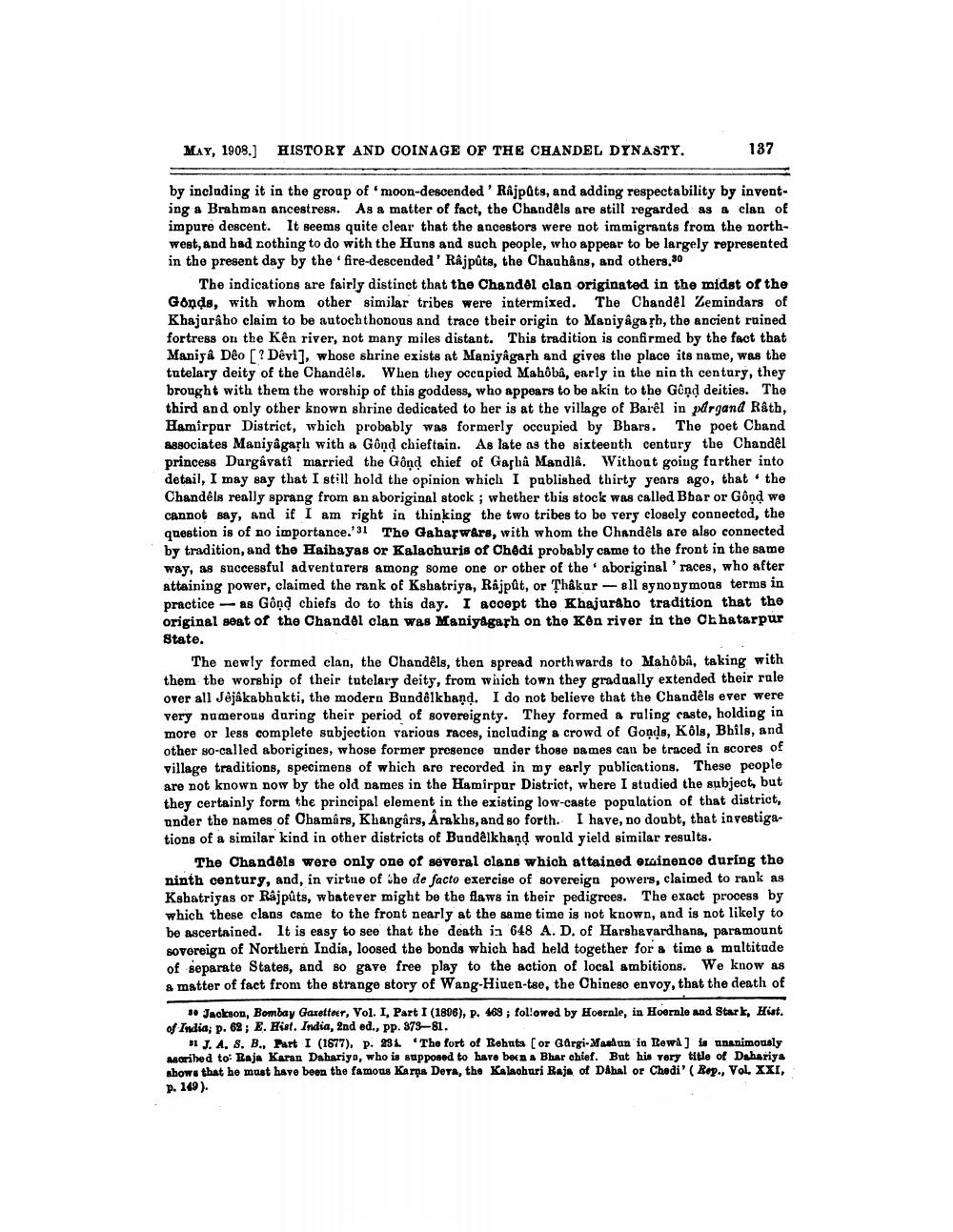________________
MAY, 1908.) HISTORY AND COINAGE OF THE CHANDEL DYNASTY.
137
by including it in the group of moon-descended 'Rajpats, and adding respectability by inventing a Brahman ancestress. As a matter of fact, the Chandels are still regarded as a clan of impure descent. It seems quite clear that the ancestors were not immigrants from the northwest, and bad nothing to do with the Huns and such people, who appear to be largely represented in the present day by the fire-descended' Rajputs, the Chauhåns, and others.80
The indications are fairly distinct that the Chandel clan originated in the midst of the Gonds, with whom other similar tribes were intermixed. The Chandel Zemindars of Khajará ho claim to be autochthonous and trace tbeir origin to Maniyâga sh, the ancient ruined fortress on the Kên river, not many miles distant. This tradition is confirmed by the fact that Maniga Deo [ ? Dévi], whose shrine exists at Maniyagarh and gives the place its name, was the tutelary deity of the Chandels. When they occapied Mahoba, early in the ninth century, they brought with them the worship of this goddess, who appears to be akin to the Gend deities. The third and only other known shrine dedicated to her is at the village of Barel in pdrgand Råth, Hamirpur District, which probably was formerly occupied by Bbars. The poet Chand Associates Maniyagarh with Gônd chieftain. As late as the sixteenth century the Chandel princess Dargavati married the Gônd chief of Gasha Mandla. Without going farther into detail, I may say that I still hold the opinion which I published thirty years ago, that the Chandels really sprang from an aboriginal stock; whether this stock was called Bbar or Gônd we cannot say, and if I am right in thinking the two tribes to be very closely connected, the question is of no importance.'31 The Gaharwars, with whom the Chandels are also connected by tradition, and the Haihayas or Kalachuris of Chedi probably came to the front in the same way, as successful adventurers among some one or other of the aboriginal 'races, who after attaining power, claimed the rank of Kshatriya, Rajput, or Thakar - all synonymous terms in practice - as Gônd chiefs do to this day. I accept the Khajuraho tradition that the original seat of the Chandel clan was Maniyagaph on the Ken river in the CE hatarpur State.
The newly formed clan, the Chandels, then spread northwards to Mahoba, taking with them the worship of their tutelary deity, from which town they gradually extended their rule over all Jejakabhukti, the modern Bundelkhand. I do not believe that the Chandels ever were very numerous during their period of sovereignty. They formed a ruling caste, holding in more or less complete subjection various races, including a crowd of Gonds, Kols, Bhils, and other so-called aborigines, whose former presence under those names can be traced in scores of village traditions, specimens of which are recorded in my early publicntions. These people are not known now by the old names in the Hamirpur District, where I studied the subject, but they certainly form the principal element in the existing low-caste population of that district, under the names of Chamârs, Khangars, Arakhs, and so forth. I have, no doubt, that investigations of a similar kind in other districts of Bundelkhand would yield similar results.
The Chandels were only one of several clans which attained erinence during the ninth century, and, in virtue of the de facto exercise of sovereign powers, claimed to rank as Kshatriyas or Rajputs, whatever might be the flaws in their pedigrees. The exact process by which these clans came to the front nearly at the same time is not known, and is not likely to be ascertained. It is easy to see that the death in 648 A. D. of Harsbevardhana, paramount sovereign of Northern India, loosed the bonds which had held together for a timo a multitude of separate States, and so gave free play to the action of local ambitions. We know as a matter of fact from the strange story of Wang-Hiuen-tse, the Chineso envoy, that the death of
*Jackson, Bombay Gaxettar, Vol. I, Part I (1806), P. 469; followed by Hoornle, in Hoernle and Stark, Hist. of India; p. 62; E. Hist. India, 2nd ed., pp. 379-81.
31 J. A. S. B., Part I (1677), p. 231. The fort of Rehuta Cor Corgi-Mashan in Rewa ) is unanimously Ascribed to: Raja Karan Dahariya, who is supposed to have been a Bhar chief. But his very title of Dehariya shows that he must have boon the famous Karpa Dera, the Kalachuri Raja of Dahal or Chedi' (Roy., Vol. XXI, p. 149).




